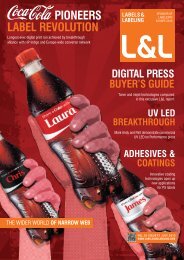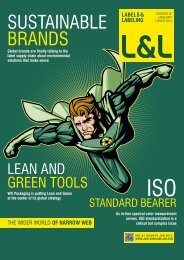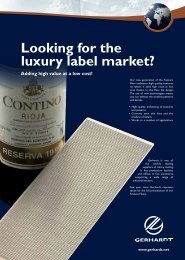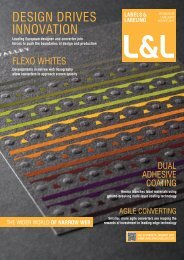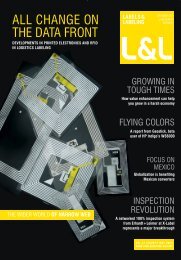You also want an ePaper? Increase the reach of your titles
YUMPU automatically turns print PDFs into web optimized ePapers that Google loves.
Labels&Labeling |87<br />
Printed electronics<br />
revolution<br />
A technology innovation center in the UK is demonstrating how converters can create their own smart<br />
label operations using standard narrow web equipment. Andy Thomas reports<br />
The Centre for Process Innovation<br />
(CPI) has installed a custom-built,<br />
multi-process narrow web Nilpeter as a<br />
test bed to develop printable electronics<br />
for a variety of applications including<br />
labels, cartons and flexible packaging.<br />
The press will form part of the Integrated<br />
Smart Systems line (ISS) which will<br />
enable electronic components to be<br />
integrated with printed circuits.<br />
Although electronic circuits are already<br />
being printed on flexible webs, these are<br />
often located in dedicated and expensive<br />
clean room operations using bespoke<br />
equipment. The project at CPI aims to<br />
demonstrate that any label converter<br />
using commercially available equipment<br />
can be part of the Integrated Smart<br />
Systems supply chain through printing of<br />
conductive inks in a standard pressroom<br />
environment.<br />
The Nilpeter press is a 16in wide<br />
machine specified to handle paper,<br />
cartonboard, films, foils and label<br />
stocks with thicknesses between 25-370<br />
microns. The modular machine includes<br />
two MO4 offset units equipped with<br />
UV curing stations; two FA4 flexo units<br />
able to run water-based, solvent and UV<br />
inks; two screen units for UV inks; and a<br />
solvent gravure unit. The press operates<br />
in both reel-to-reel and reel-to-sheet<br />
modes, and can re-register from unit 1,<br />
allowing CPI to simulate larger presses<br />
with multiple print stations. Auxilliary<br />
processes include de-lam/re-lam,<br />
UV lamination, cold foil and die<br />
cutting/sheeting.<br />
The process of manufacturing<br />
Integrated Smart Systems pieces<br />
starts with printing the label or carton’s<br />
graphic elements, followed by printing<br />
‘large area’ electronic circuits. After<br />
sheeting, the pieces are coated with<br />
conductive adhesive on a flatbed DEK<br />
screen press with a print accuracy of<br />
10 microns. A commercially available<br />
pick & place unit used extensively in<br />
the electronics sector then positions<br />
miniature components – which might<br />
include chips, flexible displays, batteries<br />
or even tiny loudspeakers – onto the<br />
printed circuit tracks.<br />
The sheets are cured in an oven to<br />
bond the components to the printed<br />
circuits, forming both a structural and<br />
electrical connection. As a final stage, the<br />
ISS sheets are converted into short runs<br />
of finished labels, flexible packaging or<br />
cartons. Finishing equipment includes an<br />
Esko Kongsberg i-XE 10 digital cutting<br />
table to cut & crease boxes and kiss cut<br />
labels. A Trotec CO2 laser handles fine<br />
cutting, engraving and ablation of circuits.<br />
The operation is also supported by CPI’s<br />
wide range of sophisticated analysis<br />
equipment to measure material, ink and<br />
structural properties.<br />
CPI Team<br />
Running the platform is ISS programme<br />
manager Bela Green, supported by<br />
technical print manager Neil Porter. Porter<br />
draws on a wealth of narrow web print<br />
operator experience at leading converters<br />
including the Clondalkin Group (formerly<br />
Harlands Labels).<br />
The CPI team is looking for partners<br />
from across the supply chain to take the<br />
ISS project forward, from brand owners<br />
and designers to suppliers of inspection<br />
equipment, substrates, inks and pre-press<br />
equipment. The ISS line at CPI is available<br />
CPI technical print manager Neil Porter in front<br />
of the multi-process modular Nilpeter press<br />
for development work, prototyping,<br />
scale-up and pilot production. A key<br />
task will be assessing the performance<br />
of the conductive inks. ‘We need to<br />
get total uniformity of ink coverage<br />
and no pin-holing or scratches on the<br />
printed surface if we are to achieve the<br />
required levels of conductivity,’ says<br />
Neil Porter. ‘So scuff and rub testing<br />
will be critically important, particularly<br />
when the label is on the applicator line.<br />
We will be evaluating print inspection<br />
systems to see if they are adequate to<br />
detect these kinds of flaws. It is more a<br />
question of uniform coating than high<br />
print resolutions.’ Another issue to be<br />
researched is how to clean conductive<br />
inks in each print process.<br />
If successful, the Integrated Smart<br />
Systems line at CPI could mark a<br />
watershed in the history of label<br />
production. For the first time, label<br />
converters of any size will be able to<br />
start up their own smart label operation,<br />
tapping into leading edge research into<br />
micro-electronics to create entirely new<br />
applications for designers and end users<br />
across the supply chain.<br />
July 2012 | L&L



